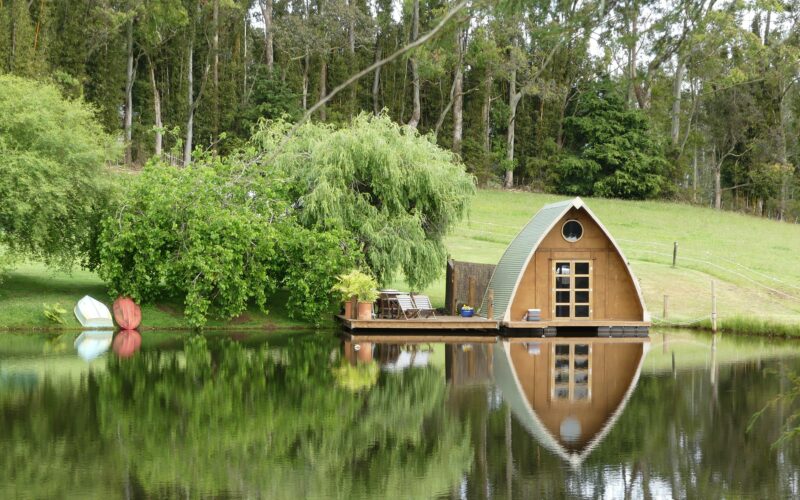We shape our dwellings, and afterwards our dwellings shape us.
-Winston Churchill
Your seller loves their home, but they’ve made the decision to move on.
Suddenly they realize that their favorite feature in their home, the elaborate koi pond in the back, may be seen as a high-maintenance nightmare for potential buyers. How are you going to find a buyer willing who’s happy to share their backyard with hundreds of giant goldfish?
Unique homes can come in all shapes and sizes. While it’s fun to check out unusual properties on sites like Zillow, selling a straw-built home in the desert may be one of the biggest challenges of your real estate career.
But you’re up for this challenge.
This guide will explore what makes certain properties harder to sell, how you can market one-of-a-kind properties, and when you should advise the homeowner to invest in remodeling.
What Is a Unique Property?
A refurbished schoolhouse, a parked set of train cars, and a remodeled church can all be classified as unique properties once they’ve been repurposed as a home. They’re unusual, quirky, and may even be classified as showstoppers by home and garden magazines.
However, homes without a bathtub, living rooms with cement floors, or elaborately landscaped gardens can also qualify a property as unique. Whether it’s a deliberate design decision that sets a home apart or a DIY project gone awry, uncommon features in a home can make it a challenge to find the next buyer.
Why It’s Difficult to Sell a Unique Home
The beginning of every real estate consultation involves a comparative market analysis (CMA), upon which many of the seller’s decisions are based. For unique homes, finding a comparable home may be a much more difficult task. Lenders base their home loans on comparable homes in the appraiser’s report, and even Fannie Mae weighs in that some homes where a “reliable opinion of the market value” is unavailable cannot be backed by a government loan.
As you try to settle on a competitive price, try these tips:
- Expand your geographic location.
- Go back further in time for similar homes.
- Use the Cost Approach Method to evaluate a price from the ground up.
- Look for comps in similar cities, municipalities, or locations.
Marketing a One-of-a-Kind Property
For Darren Miller, a real estate broker with Hero Homes Group in Cleveland, TN, one of his most memorable properties was a 1900s farmhouse located in a flood plain. After the previous real estate agent let the listing expire, Darren’s brokerage took on the challenge of finding a buyer for an older property with an insurability challenge.
Miller says that social media algorithms have changed how they can market. Because of the Fair Housing Act (FHA), real estate agents can no longer target ads based on demographics like income, profession, and age. For Miller, marketing unique properties isn’t that different from marketing an average home. “It’s all about exposure and getting more eyes on a property”, he says.
No matter what condition a property is in, Miller says that he uses these three steps:
- Presentation. Every property, regardless of its situation, gets treated to professional photography. This is the cornerstone of Miller’s marketing approach, and it drives his marketing campaigns.
- Marketing. Miller’s website Hero Homes Group has a robust online presence and sees over 20,000 unique visitors a month. By publishing a home listing on his own network, he can put it in front of 20,000 prospective buyers. He also advertises his properties on multiple MLSs, and he starts with a minimum of three additional MLSs from surrounding markets. Finally, he runs Google Pay Per Click ads (PPC) and funnels traffic from his social media accounts to his property listings.
- Open House. Right now, not every homeowner is thrilled about opening their home to the public. However, Miller uses several marketing techniques that capitalize on open houses, and he can continue to target home buyers even if the homeowner isn’t interested in an open house. He knows that neighbors may have friends or family members who want to live nearby, so his team reaches out to neighbors to ask for leads in a process he calls circle dialing or circle prospecting. By micro-targeting the neighborhood around a unique property, Miller taps into a niche group that’s already familiar with the property and area.
Should a Seller Remodel Their Uncommon Property?
As the expert in the home-selling situation, you’ll need to know when to step up your marketing game, and when to admit defeat and advise the homeowner to remodel part of their home. If the seller’s gone all out on football team pride and painted their entire home orange and blue, spending a few thousand dollars on a paint job may be all you need to do to remove the shock factor from the property.
Conversely, the uncommon feature may be an excellent selling point to just the right buyer. An underground Hobbit-like home reminiscent of the Shire may be exactly what a Lord of the Rings fan has always wanted. You’ll need to advise the seller on the best way to stage and present their one-of-a-kind home.
The Bottom Line
Selling a unique property doesn’t need to be hard or complicated. When you have a solid marketing plan based on excellent pictures, a website and ads, and an open house that reaches out to neighbors for leads, you’ll be able to sell any property that you encounter. In the end, a property’s value is established by how much a buyer is willing to pay for it, so broadening your advertising reach will increase your chances of putting the property in front of the perfect buyer.






